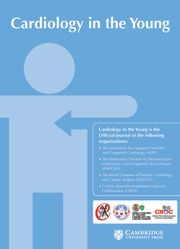Article contents
Pulmonary reperfusion injury in post-palliative intervention of oligaemic cyanotic CHD: a new catastrophic consequence or just revisiting the same old story?
Published online by Cambridge University Press: 18 October 2023
Abstract
Pulmonary reperfusion injury is a well-recognised clinical entity in the setting pulmonary artery angioplasty for pulmonary artery stenosis or chronic thromboembolic disease, but not much is known about this complication in post-palliative intervention of oligaemic cyanotic CHD. The pathophysiology of pulmonary reperfusion injury in this population consists of both ischaemic and reperfusion injury, mainly resulting in oxidative stress from reactive oxygen species generation, followed by endothelial dysfunction, and cytokine storm that may induce multiple organ dysfunction. Other mechanisms of pulmonary reperfusion injury are “no-reflow” phenomenon, overcirculation from high pressure in pulmonary artery, and increased left ventricular end-diastolic pressure. Chronic hypoxia in cyanotic CHD eventually depletes endogenous antioxidant and increased the risk of pulmonary reperfusion injury, thus becoming a concern for palliative interventions in the oligaemic subgroup. The incidence of pulmonary reperfusion injury varies depending on multifactors. Despite its inconsistence occurrence, pulmonary reperfusion injury does occur and may lead to morbidity and mortality in this population. The current management of pulmonary reperfusion injury is supportive therapy to prevent deterioration of lung injury. Therefore, a general consensus on pulmonary reperfusion injury is necessary for the diagnosis and management of this complication as well as further studies to establish the use of novel and potential therapies for pulmonary reperfusion injury.
Information
- Type
- Review
- Information
- Copyright
- © The Author(s), 2023. Published by Cambridge University Press
References
- 1
- Cited by


